So we've gone from design goals to our first high-level design, which is:
# Eminence Legend CB15 15" bass-guitar speaker,
# 5.6 cubic foot enclosure (internal volume of air)
# two 4" ports, 7.5" long, with flared ends
Is it time to hit the woodshop? Well, I checked my tape-measure, and there's no scale in "cubic feet", so there remains a little more work to be done.
Box ShapeInside the cabinet, sound waves reflect back and forth between the walls. Between parallel walls, standing waves will form at wavelengths that are multiples of 4x the distance between those walls (wavelength is related to frequency). Each frequency at which a standing wave forms represents a box resonance which will create a peak in the speaker's frequency response. Imagine the worst case: a perfectly square cabinet. The standing-wave frequencies between all three pairs of opposite walls will be the same, resulting in huge peaks in response!
So the first rule is to ensure that the box dimensions (length, width, height) are not equal, or integer multiples of each other.
Standing waves can be reduced further by using non-parallel surfaces (e.g. a trapezoidal box) and curved surfaces, but I'm not a woodworking pro. I will go with a rectangular cab.
5.6 Cubic Feet of What?Air. The air in the box acts as both a spring that supports the cone, and as an oscillating mass. In order for our rectangular box to contain the right amount of air, we need to add the volume of the driver and the ports, and any other internal features of the cabinet! The volume of the ports was easy to calculate, as they are simply cylinders (ignoring the flares): V = 1/4*pi*diameter^2*length. The volume of
the back of the driver took a little more work. Some people wrap their driver in plastic and lower it into a calibrated bath of water, but I wasn't feeling that adventurous! I took some measurements with the tape measure, and approximated the driver as a disk (the magnet) and a truncated cone (the driver). The volume of a cone is V = 1/3*pi*radius^2*height.
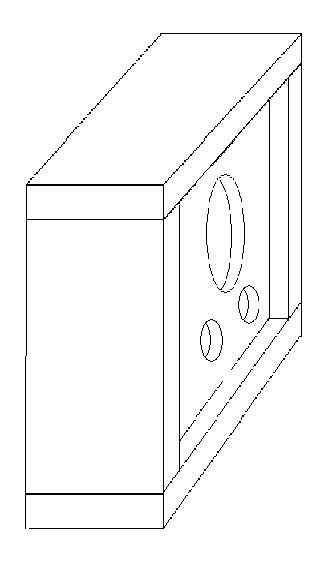

It's necessary at this point to decide what kind of joinery will be used. I used butt joints with corner braces ("battens"), because they're much easier to make than dovetail or other fancier joints, and quite strong when glue is used. Their drawback is that I must take into account the volume displaced by the battens. Besides the battens, internal braces are strongly recommended for big cabinets, to reduce vibration in the walls. I plan on installing one internal brace which will look something like this:
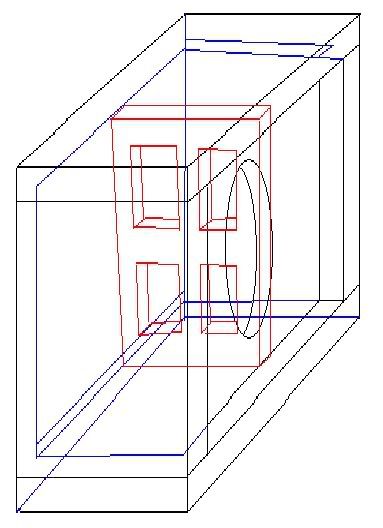
And one more consideration is the thickness of the panels. I put together a little spreadsheet that takes all these into account and calculates the box's outer dimensions. This allowed me to adjust things like port length without having to re-calculate everything by hand. It also allowed me to play with the shape of the box, by picking the width and depth that I wanted, and letting the spreadsheet calculate the required height. If you'd like a copy of the spreadsheet, just email me.
I set the cabinet width equal to the width of the Traynor amp: 28". The Traynor is only about 10" deep, so I had some freedom in choosing the depth of the cab. I tried a few shapes until I settled on one that would fit in my trunk (just), and that could be cut from one 4'x8' sheet of plywood! The final outer dimensions are:
28" Wide x 15" Deep x 33.5" HighYeah, that's a big cab. Almost twice the size of your average 1x15 cab you'll see in the music shops. Eminence says this driver should sound good in a box almost one-third this size. A 4'x8' sheet of 3/4" plywood is pretty heavy (~45lbs), and this box is going to use most of one whole sheet. "Deep, Tight, Small: Pick any two." Do I really need the deepest possible bass response? Couldn't I live with a bit more dispersion (group delay) on the lowest notes? Once I add the 17lb driver, the battens and braces, the screws, the glue, the handles, corners and carpet, this thing's gonna weigh...
Aw screw it, let's build 'er anyway! Full steam ahead!Checks:
# Is there room on the front for one 15" driver and two 4" ports? Yes.
# Will it fit in the trunk of the car?? Yes!
I was all set to start building. I made my shopping list for the hardware store, and waited for the weekend to come. Unfortunately, that gave me too much time to think, and to continue researching...
Snag #1: Source Resistance
Present-day speaker DIYers have it easy, thanks to modern amplifier technology. Solid-state amps closely approximate an "ideal current source" - they maintain a constant output voltage no matter the load. Example: when you halve the load (go from 8-ohm to 4-ohm speakers), you double the output power. In other words, their source resistances are so close to zero that speakers can be designed "in a vacuum", with no consideration for the electronics that will power them.
The night before I went to buy the materials for the cabinet, I learned that life is not so simple when considering a tube amp!
Why is the amp's source resistance important to the speaker design? The answer has to do with damping.
A speaker, simply speaking, is a mass on a spring. The mass is the speaker cone and voice coil, and the spring is the cone's suspension: the surround and spider. A mass on a spring will bounce up and down at a resonant frequency that depends on the stiffness of the spring and the mass of the... mass. In accoustic terms, the speaker is very sensitive (i.e. loud) at frequencies close to its resonant frequency.
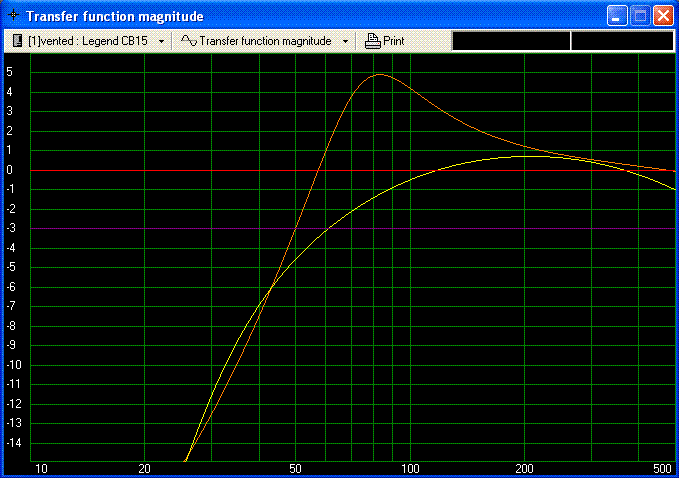
Freq. Response of a properly damped speaker (yellow) and an under-damped speaker (orange)
A mass on a spring will bounce indefinitely unless there is some damping force. To draw another example, a car is also a mass on a spring (actually, on four springs). Anyone who has driven a car with worn-out shocks knows the importance of good damping! Similarly, damping is built into a speaker driver, but not with separate components like shocks. A speaker's primary damping mechanism is its motor, and something called counter-current.
Any electrical motor is also a generator, and any electrical generator is also a motor. This holds true for the speaker motor, too: the magnet and voice coil. As the signal from the amp creates the force that moves the coil, so does the motion of the coil generate a current in the speaker wire, but in the opposite direction to the signal current! When the signal from the amp is removed, the speaker cone's momentum continues to generate counter-current. And because any generator is also a motor, this counter-current creates a counter-force which opposes the speaker's own movement. In the absence of a signal, the speaker will quickly come to rest. In other words, the speaker motor damps speaker motion. This "electrical damping" is the speaker's primary damping mechanism.
Because electricity must travel in circuits, the counter-current actually flows backwards along the speaker wires, through the output transformer of the amp, and back. Therefore, the counter-current experiences the amp's source resistance. Since the source resistance of modern solid-state amps is nearly zero, speakers will experience maximum electrical damping no matter which amp they're connected to. Speakers can generally be designed without regard for the peculiarities of the amp which will drive them.
But tube amps have significant source resistance. This reduces the available electrical damping, which makes the speaker much more responsive near its resonant frequency! This is one reason why tube amps are described as having a "warmer" tone: they make the speaker more responsive in the bass region. Unfortunately, the extra resonance also adds to group delay in the region of the peak (there are no free lunches). While cheap automotive subwoofers will take advantage of the extra bass of an underdamped speaker, we can not tollerate such a boomy, muddy sound in a bass-guitar cabinet!
I discovered that the WinISD software has a field where the user can specify the source resistance, and the software will model the effect on the speaker system's performance. But what value should I enter? I spent the next few days researching on the web.
There is not much documentation available on my 30+ year-old amplifier. I found the schematic, but (I'm ashamed to say) don't know how to derive the source resistance from it. It should be the output impedence of the power stage, reflected through the output transformer, and considering the negative feedback (the very purpose of which is to reduce the source resistance). I tried measuring it indirectly, by measuring the voltage and current through two different loads, but the answer was an unbelievable 14.8 ohms! This value created an enormous peak in the calculated mid-bass response, and I was worried. Any changes I made to the alignment to mitigate this peak had other undesirable effects (increased group delay /phase distortion, loss of deep bass response, etc). But given that the recommended speaker load for this amp is 4 to 8 ohms, a source resistance higher than that is unlikely.
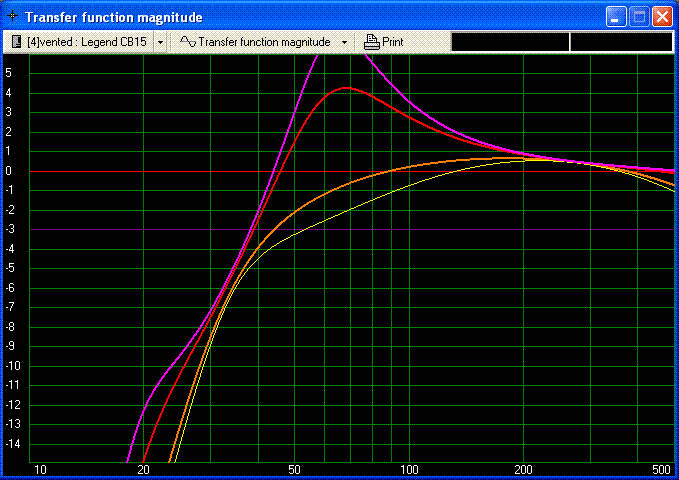
Freq. Response of my cabinet with amp source resistance of 0-ohms (yellow), 1.25-ohms (orange), 8-ohms (red) and 14.8-ohms (purple). More bass isn't always better bass: look at the steep slope in the 40-70Hz range. This would make playing with an even tone almost impossible.
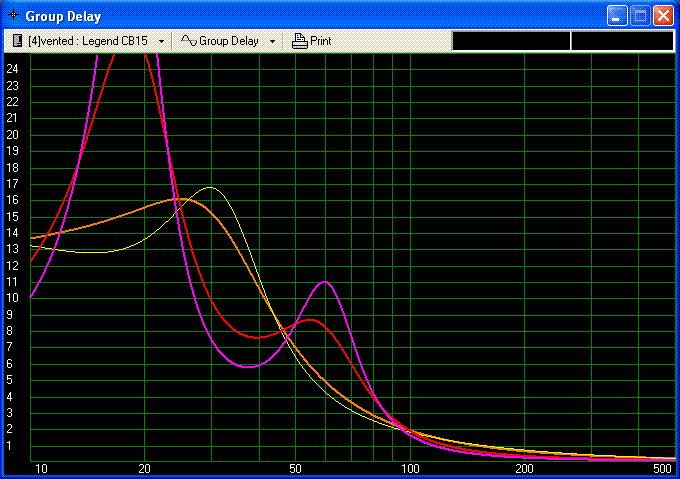
Group Delay of my cabinet with amp source resistance of 0-ohms (yellow), 1.25-ohms (orange), 8-ohms (red) and 14.8-ohms (purple). Despite the untidy peaks in the 40Hz+ region, the magnitude of delays remains below 12ms, which is quite acceptable.
I got a good discussion going on
www.diyaudio.com's forum. Some experts argued that the most likely SR was 8 ohms (to match the recommended load), but others quoted 1 to 1.5 ohms as typical. The most credible commentor referred to a figure of 1.25 ohms for a "textbook push-pull UL tube amp" (I don't know what the UL stands for; anyone?). 1.25-ohms sweetens the mid-bass response of the speaker by 1-2dB, which will be quite tollerable (perhaps even pleasing). I decided not to modify my cabinet design.
Ironically, some of the speaker drivers which I had rejected earlier in the reseach phase (e.g. the Tone Tubby 15" bass speaker) for having too little bass extension would have matched the tube amp better than the CB15, which by this time I had already purchased!
Next time: Construction begins...
-Bionic



